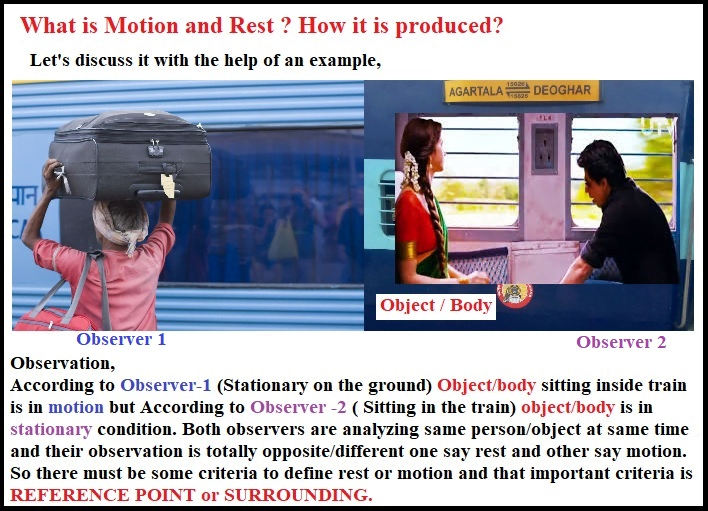Rest and Motion
Table of Contents
Rest and Motion concepts:
If the position of a body changes with respect to its surroundings with respect to time, then the body is said to be in a state of motion.
If the position of a body does not change with respect to its surroundings with respect to time, then the body is said to be in a state of rest.
Nobody in the universe is in a state of absolute rest or motion. Rest and motion are relative terms, and defined on the basis of the surrounding or reference point, which may be stationary or in a moving condition.

Let’s understand this with the help of few examples.
Example 1: At present, we are sitting in this room. We are in a state of rest with respect to our surroundings, but with respect to other planets or stars, we are in a state of motion as we are sitting on earth and the earth is moving with respect to other planets or stars.
Example 2: Two person riding two different cycle in the same direction with same speed, both are in state of rest with respect to
each other but in moving condition with respect to surrounding.
If distance between reference point and body change then body will be definitely in state of motion.
Click here 🖱️👉 Motion Graphs Class 9 Quiz-2
Important Questions
What is rest?
A: Rest refers to the state of an object where it is not changing its position with respect to a given reference point over time.
What is motion?
A: Motion refers to the change in position of an object over time in relation to a reference point.
What is the difference between rest and motion?
A: Rest refers to the absence of motion, whereas motion involves a change in position over time.
Can an object be at rest and in motion at the same time?
A: No, an object cannot be at rest and in motion at the same time. An object is either at rest or in motion, depending on whether or not it is changing its position with respect to surrounding over time.
What is the difference between uniform and non-uniform motion?
A: Uniform motion refers to motion at a constant speed in a straight line. Non-uniform motion, on the other hand, refers to motion that is not at a constant speed or that involves changes in direction.
What is the difference between speed and velocity?
A: Speed is a scalar quantity that refers to the rate at which an object covers distance. Velocity, on the other hand, is a vector quantity that refers to the rate at which an object changes its position in a particular direction.
What is acceleration?
A: Acceleration is the rate at which an object changes its velocity over time. It can be either positive (speeding up) or negative (slowing down).
What is Newton’s first law of motion?
A: Newton’s first law of motion, also known as the law of inertia, states that an object at rest will remain at rest, and an object in motion will remain in motion with a constant velocity, unless acted upon by an external force.
Can an object be at rest and have acceleration?
A: No, an object at rest cannot have acceleration since acceleration involves a change in velocity, and an object at rest has zero velocity.
Can an object be in motion and not have acceleration?
A: Yes, an object can be in motion and not have acceleration if it is moving at a constant speed in a straight line (in uniform motion).
What are different types of motion?
Answer: There are different types of motion:
a. Translational Motion: This type of motion involves the movement of an object in a straight line or along a curved path. For example, a car moving on a highway, a ball rolling down a slope, or a person walking in a park.
b. Rotational Motion: Rotational motion occurs when an object spins or rotates around a fixed axis. Examples include the spinning of a wheel, the motion of a ceiling fan, or the Earth rotating on its axis.
c. Oscillatory Motion: Oscillatory motion is characterized by back-and-forth or repetitive motion around a central position. Examples include the swinging of a pendulum, the vibration of a guitar string, or the motion of a child on a swing.
d. Circular Motion: Circular motion involves an object moving in a circular path around a center point. Examples include a satellite orbiting the Earth, a race car going around a racetrack, or a spinning top.
Pages
Rest and Motion, Rest and Motion, Rest and Motion, Rest and Motion